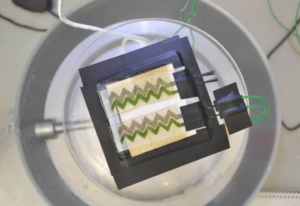
Researchers at Imperial College London have created a two-in-one solar bio-battery and solar panel by printing living cyanobacteria and circuitry onto paper. The photosynthetic microorganisms have been used as ink and printed onto conductive material. The resulting experiment was able to harvest the sun’s energy and provide small amounts of electricity.
An article on TechXplore reported the team used cyanobacteria as an ink and printed, via inkjet printer, precise patterns onto electrically conductive carbon nanotubes, also inkjet-printed onto the piece of paper. The team showed that the cyanobacteria survived the printing process and were able to perform photosynthesis so that small amounts of electrical energy could be harvested over a period of 100 hours.
“Imagine a paper-based disposable environment sensor, disguised as wallpaper, which could monitor air quality in the home. When it has done its job, it could be removed and left to biodegrade in the garden without any impact on the environment,” says Dr. Marin Sawa, Department of Chemical Engineering.
The solar bio-battery propels research into microbial bio-photovoltaics (BPV) technology. It capitalizes on the abilities of cyanobacteria, and other algae that use photosynthesis, to convert light energy into an electrical current using water as the source of electrons.
TechExplore stated that one of the advantages of using BPVs to harvest energy from cells like cyanobacteria is that they can carry on producing electricity even in the dark by using molecules produced in the light.
Dr. Andrea Fantuzzi, Department of Life Sciences, Imperial College London, a co-author of the study, suggested that the low-power output makes the BPVs suited to applications and devices such as environmental quality sensors or sensors for monitoring patients with diabetes.
The team is hopeful that this proof-of-concept using an off-the-shelf inkjet printer to construct BPVs demonstrates a potential method for easily scaling up for wider use in multiple industries.
 TEXTILES.ORG
TEXTILES.ORG


